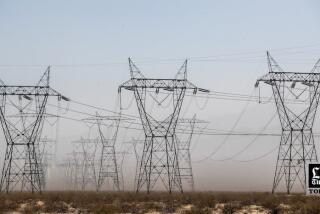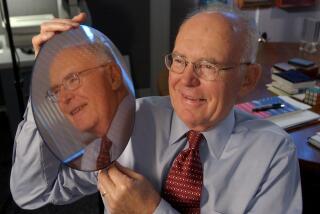‘Cosmos’ recap: Michael Faraday, ‘The Electric Boy’
- Share via
We take so much of modern technology for granted: radio, telephones, film and television, computers, and the Internet all enable us to communicate at the speed of light. But we would not have any of those things without the efforts of hundreds of scientists from ages past, each building on the efforts of those who came before. This week’s episode of “Cosmos,” “The Electric Boy,” focuses on one in particular: the 19th century physicist Michael Faraday.
Faraday was born into poverty in a squalid London suburb and did not have a positive experience with school, in part because he had a speech defect as a child. He sounds like Elmer Fudd in the animated sequence, pronouncing “rabbit” as “wabbit” and his last name as “Fawaday.” Let’s just say that his teacher was unsympathetic. His mother took him out of school, thus ending his formal education.
------------
FOR THE RECORD
An earlier version of this post said that Michael Faraday undertook a complicated experiment to prove that light was closely linked to electricity and magnetism in 1940. It was 1840.
------------
At 13, however, he was apprenticed to a book binder, binding the tomes by day and poring over the texts at night. That’s how he learned about electricity, which became a lifelong fascination. When he was 21, a friend gave him a ticket to a public lecture and science demonstration at London’s Royal Institution by renowned chemist Humphrey Davy.
Faraday was riveted by Davy’s lecture, taking such copious notes on this “mysterious force of electric fluid” that he failed to applaud with the rest of the crowd. He used those to create a transcript of the lecture, which he then bound into a book as a gift for Davy. Faraday didn’t want to be a tradesman, you see — he wanted to be a scientist, like Davy. He just didn’t have the right socio-economic credentials in class-conscious England at the dawn of the 19th century.
When a chemical explosion in the lab temporarily blinded Davy, he remembered the young man with the prodigious memory and hired him as a secretary. While he dismissed Faraday’s scientific aspirations, advising him to stick to book binding, the young man quickly became indispensable to him, eventually becoming his lab assistant.
One day Davy was trying to re-create a famous electromagnetism experiment with fellow chemist William Wollaston, wondering why applying an electric current to a wire caused that wire to behave like a magnet. Clearly the forces were connected. Davy longed to find a way to exploit this temporary effect to induce mechanical motion for practical applications rather than a novelty toy for public demonstrations, but nobody had figured out how to make it happen continuously. He teasingly told Faraday to try his hand at it after he was done cleaning the lab.
The joke was on Davy: Faraday figured it out, and the result was the first induction motor, which converts electrical current into continuous mechanical motion. (The animated sequences in this episode brought Faraday’s various experiments vividly to light — an impressive accomplishment, since they can be difficult to visualize.)
The induction motor started a revolution: electric fans, air conditioning, sewing machines, power tools, phonographs, cars and so forth all grew out of Faraday’s simple device.
You’d think Davy would be delighted that his young protégé was now the toast of London. Instead, he was kind of jealous. It didn’t help that people were saying that Faraday was his greatest discovery, despite Davy’s many scientific accomplishments. To get his rival out of the way, Davy set Faraday an impossible task: trying to reverse engineer the secret glass-making process invented by Bavarian scientist Josel Frauenhaufer that made Bavarian glass so superior, especially for lenses in telescopes and microscopes.
Faraday never learned the secret, despite four years of effort and repeated failures. He kept a single glass brick on a shelf as a souvenir of this disheartening period in his scientific career.
Fate intervened again on Faraday’s behalf when Davy died and Faraday succeeded him as head of the laboratory. Now he was free to pursue whatever he liked, and he made another revolutionary invention. He noticed that a moving magnet could induce an electrical current, converting motion into electricity, pretty much on demand. That’s right: We can thank Michael Faraday for the generator.
That would have been enough to cement his place in the history books, and in February 1840, it seemed like that would be it. Faraday suffered a breakdown of sorts, struggling with depression and memory loss for the rest of his life. But he was Michael frickin’ Faraday. He persevered, undertaking a complicated experiment to prove that light was closely linked to electricity and magnetism.
Remember that piece of glass he kept on his shelf as a reminder of his failure? That turned out to be the key to his success. There’s a lesson in there, people. Anyway, he showed that light could become polarized — isolated into a single wave rather than spreading out randomly in all directions at once — in the presence of a magnet.
He also tinkered with the classic experiment of sprinkling iron filings on a sheet of paper near a magnet, giving rise to pretty patterns. He showed that these patterns weren’t a property of the iron filings — they were evidence of invisible magnetic fields that filled the empty space around the magnet. Similar patterns could be produced with electrical fields.
And Faraday went one step further, proposing that the movement of those fields gave off electromagnetic radiation, more commonly known as light. This is where his lack of formal education cost him: He had some intriguing experimental results and a strong intuitive argument to explain them, but his ideas were dismissed as mere handwaving because he couldn’t do the math. And math is the language of physics.
Fortunately, a young physicist named James Clerk Maxwell — the polar opposite of Faraday, born to wealth and privilege — did have the mathematical skills and thought Faraday was onto something. It was Maxwell who translated Faraday’s ideas into a set of equations that are now part of the most basic foundation of modern physics. And the revolution was complete: We now know that electromagnetic waves are dynamic, spreading out at the speed of light. And we’ve learned to harness that force to communicate with one another across vast distances.
Faraday made one other vital contribution: He founded the annual Christmas lectures at the Royal Institution, beginning with his classic talk on the chemical history of the candle. He never forgot his humble roots, you see, and how transported he had been when he first saw Davy demonstrate electromagnetism. He ensured that young people in subsequent generations would always have that opportunity.
Carl Sagan, host of the original “Cosmos,” was among the prominent scientists who gave one of those lectures. Sagan, like Faraday before him, and Neil de Grasse Tyson after him understood: The wonder of science belongs to everyone.
More to Read
The complete guide to home viewing
Get Screen Gab for everything about the TV shows and streaming movies everyone’s talking about.
You may occasionally receive promotional content from the Los Angeles Times.






